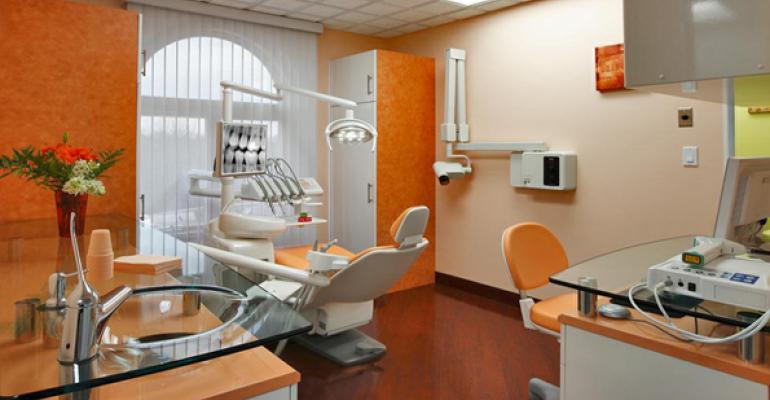Two medical office building conferences held within the past week have offered a significant amount of information for owners, developers and investors in the industry.
Annapolis, Maryland-based Revista unveiled its new database on just about every medical office building (MOB) in the country, as well as construction data on the sector. Also, the Washington, D.C.-based Advisory Board Co. detailed how the design of the new MOB buildings should focus on patient convenience.
According to Revista, there are more than 36,000 investment-grade medical properties in the country, defined as purpose-built health care facilities that are greater than 7,500 sq. ft. This includes more than 5,000 hospitals, totaling 1.5 billion sq. ft., and more than 31,000 sq. ft. of medical office buildings, totaling 1.3 billion sq. ft.
Though this is the first year of data collection for the firm, Revista provided some interesting data about the industry: Only about 25 percent of the MOBs are on campus, while the rest are located off-campus; about 62 percent of the MOBs are affiliated with a health care provider; and REITs only own about 9 percent of all MOBs. A vast amount of the real estate is owned by hospitals, health systems and providers.
“I think the amount owned by REITs was a surprise, we’ve had comments from the industry that they thought the REITs owned more than they did,” says Elisa Freeman, a principal with the firm.
Health care providers also make up the majority of the top 50 companies by median real estate value, according to the Revista data. Oakland, California-based Kaiser Foundation Hospitals is at the top of this list, with almost $31.7 billion of medical assets owned in 2013. Health Care REIT Inc. and Ventas Inc. are number two and three on the list, with more than $20 billion owned each.
Revista also released geographic data on the top 10 markets for MOBs, which make up about 6,639 properties, totaling 335 million sq. ft. New York City, Los Angeles and Chicago are the three largest metros for these assets, with more than half of the properties (the Big Apple has almost 100 million sq. ft.). Washington, D.C. rounded out the top 10 list, with about 17 million sq. ft., and is on the lower side of the scale considering MOB sq. ft. per capita compared to the other top metros, at 2.9 sq. ft. However, the district’s metro, by far, is the most active with construction per sq. ft.
“Pretty much every hospital in the Washington, D.C. area has renovations going on right now,” says Hilda Flower Martin, a Revista principal. “New York City has the most construction going on overall, about $4 billion. About $1.2 billion of that is for MOBs.”
It’s well known that demand for MOBs is high. According to Revista, prices for MOBs have risen to $268 per sq. ft. this year, about $20 per sq. ft. higher than last year, and yields have compressed to about 7.1 percent for all health care properties. There’s about 5.5 million sq. ft. of MOB completions expected in 2014, and about seven million sq. ft. of completions expected in 2015, according to the company’s data.
More convenient designs
But medical office complexes being built today will look a lot different than current stock, according to comments made at the Advisory Board webinar titled “The Patient-Centered Ambulatory Facility,” held on Nov. 24. According to the webinar, sponsored by Duke Realty, MOB developers and renovators are responding to patients’ desire for convenience, specifically for closer-to-home facilities and less waiting times for service.
Ambulatory facilities make up about 71 percent of all new MOB construction projects planned in the next three years, according to the webinar. An ambulatory facility includes retail clinics, urgent care, freestanding emergency facilities, imaging centers and surgical centers. Competition, as more companies try to reach out to the growing health care customer base with smaller, specific health care facilities, has forced MOB owners/developers to try to reduce bottlenecks in patient flow and build on convenient sites.
According to the Advisory Board, in a survey of 4,000 consumers, 63 percent rated “wait time to be seen by a doctor” as the most important factor of where they would go for care. To improve wait times, developers are experimenting with lobby, check-in and patient room designs, according to the Advisory Board. Where formerly a patient would line up to check in for any issue, new solutions may include in-room check-in/check-out, tablet-based check-in or even electronic kiosks that can lower check-in times to two minutes vs. the current 20 minutes. Other changes include removing some doctor’s rooms to add educational spaces and larger, more comfortable rooms for group visits.
Deeni Taylor, executive vice president of Duke Realty’s healthcare division, said that in today’s health care environment, it’s essential for hospitals and systems to implement innovative space configurations and design solutions in their outpatient facilities.
“This will help differentiate them from the competition, attract and retain more consumers, build sustained brand loyalty and ultimately help the providers grow their business,” he said in a statement.

